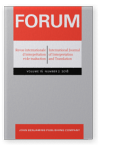Vol. 16:2 (2018) ► pp.303–323
Le sous-titrage et le commentaire au service d’un mythe
La sémiotique des spots publicitaires français pour les soins à la télévision grecque
Dans cette étude nous mettrons en valeur la dimension sémiotique du sous-titrage en grec et du commentaire de spots publicitaires français qui traitent des soins corporels. Il s’agit de spots publicitaires qui lancent sur le marché grec des produits de soins corporels de la marque Le petit Marseillais. L’étude se fait tant au niveau interlingual qu’au niveau intersémiotique. Nous allons voir que le choix sémiotique du sous-titrage est lié aux connotations positives de la société grecque concernant la langue française lorsqu’ elle est utilisée dans la publicité de produits cosmétiques et de soins corporels. Par ailleurs les sous-titres traduisent parfois intersémiotiquement les dialogues du spot et le contenu de l’image ce qui facilite le transfert culturel de la valeur de la méditerranéité avec laquelle les Grecs sont familiarisés. Les constatations principales tirées sont que le sous-titrage ne s’éloigne pas de la langue source, préservant ainsi les mêmes isotopies sémantiques, et que la traduction intersémiotique est une caractéristique commune des spots publicitaire qui se fait entre les énoncés verbaux français ou les sous-titres grecs et le contenu de l’image. Enfin, les commentaires grecs reproduisent les informations essentielles du texte français effacé, ce qui dote les spots d’une valeur supplémentaire grâce à leur caractère médiatique et narratif.
Article outline
- 1.Traduire une publicité, traduire un mythe
- 2.Les spots publicitaires Le petit Marseillais en Grèce
- 3.Le sous-titrage en Grèce et le commentaire
- 4.Les spots publicitaires sélectionnés
- 5.Le sous-titrage des spots publicitaires
- 6.Le commentaire des spots publicitaires
- 7.L’aspect intersémiotique des spots publicitaires
- 8.La semiosphère traduite
- 9.Pour conclure
- Remarques
-
Références
Article language: French
